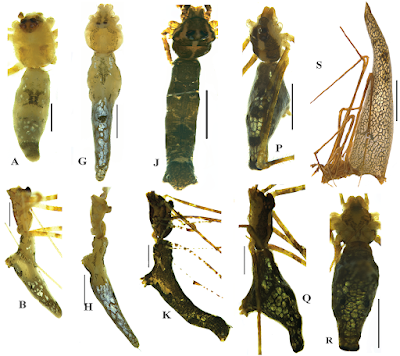 |
A, B Rhomphaea shanthi sp. nov. G, H R. jacko sp. nov. J, K R. marani sp. nov. P–S R. martini sp. nov. Tharmarajan & Benjamin, 2022 |
Abstract
Sri Lanka is a biologically diverse South Asian island, and together with the Western Ghats (Southern India) is one of the 36 world’s most biologically diverse areas. Here, we investigated the origin and diversification of Rhomphaea and Neospintharus of Sri Lanka using sequences of three genes: mitochondrial cytochrome c oxidase I (COI) and 16S rRNA (16S); and nuclear 28S rRNA (28S). Our phylogeny included 32 taxa (30 ingroup and 2 outgroup). We used Bayesian Inference and maximum likelihood methods to reconstruct the placement of species, divergence time estimations and their foraging behavior with an emphasis on species from Sri Lanka. Our phylogenetic hypothesis support the monophyly of Argyrodinae as well as the monophyly of Rhomphaea, where Rhomphaea is a sister group of Neospintharus. Further, our analysis also suggests that Sri Lanka was colonized by Argyrodinae several times. Additionally, the following new species are described: Rhomphaea shanthi sp. nov., Rhomphaea jacko sp. nov., Rhomphaea martini sp. nov., Rhomphaea marani sp. nov., Neospintharus kandelensis sp. nov. and Neospintharus ohiyiaensis sp. nov.
Mathura Tharmarajan and Suresh P. Benjamin. 2022. Origin and Diversification of Free-living Stick Spiders of Sri Lanka including the Description of Four New Species of Rhomphaea L. Koch, 1872 and Two New Species of Neospintharus Exline, 1950. PLoS ONE. 17(9): e0273105. DOI: 10.1371/journal.pone.0273105


